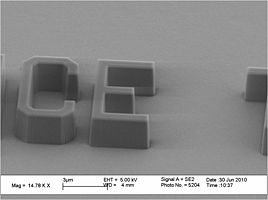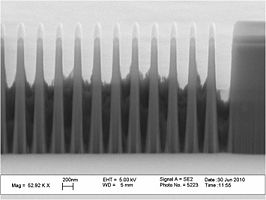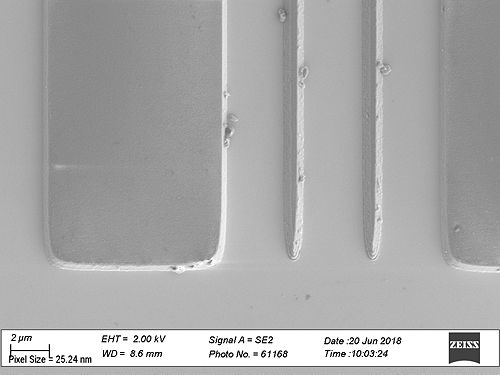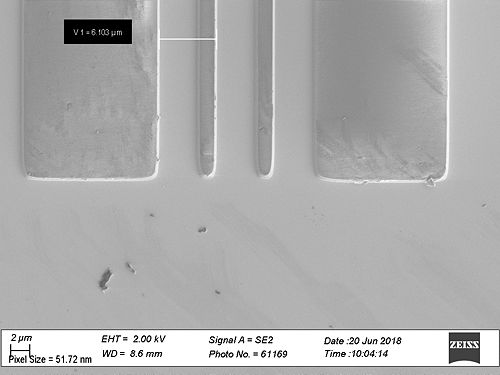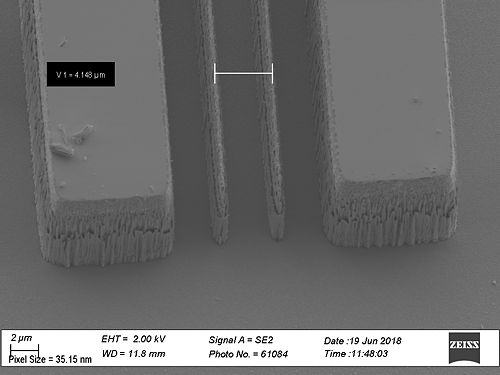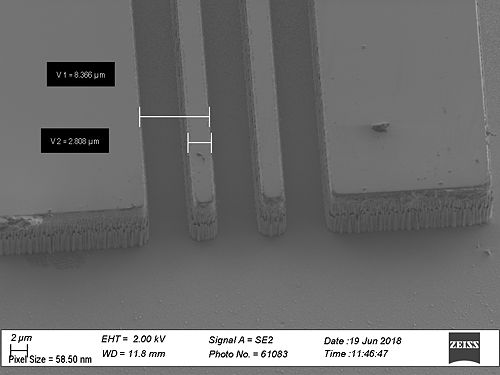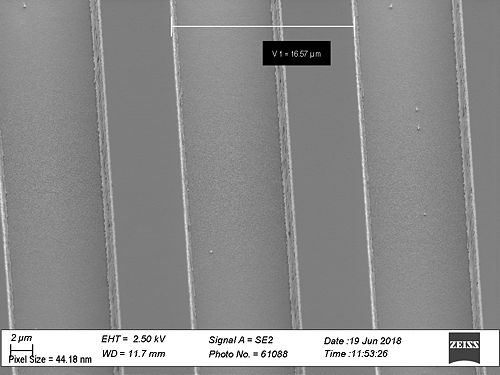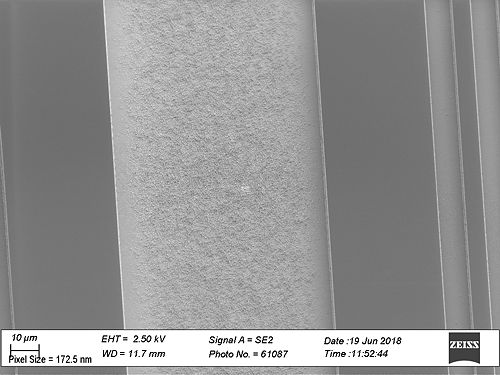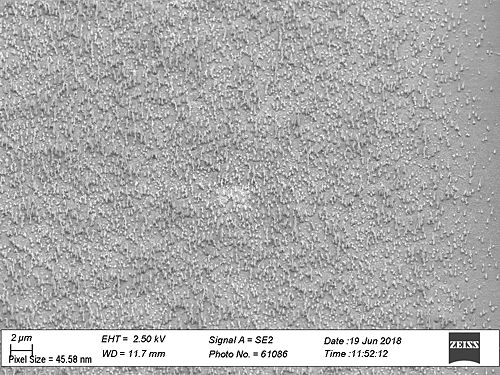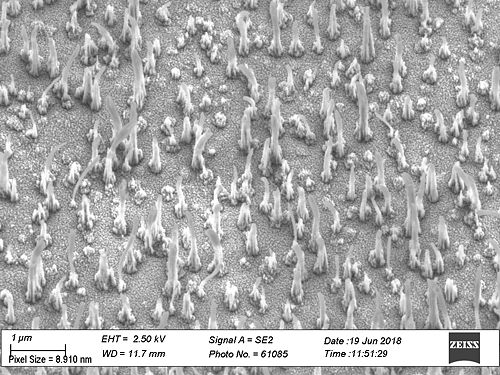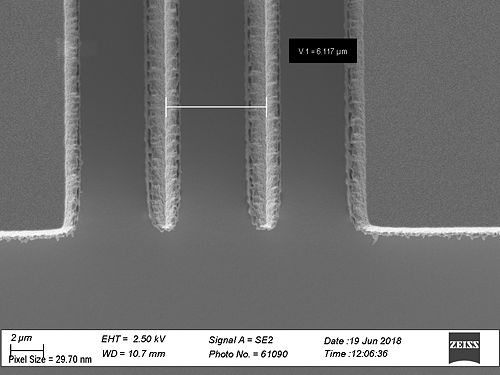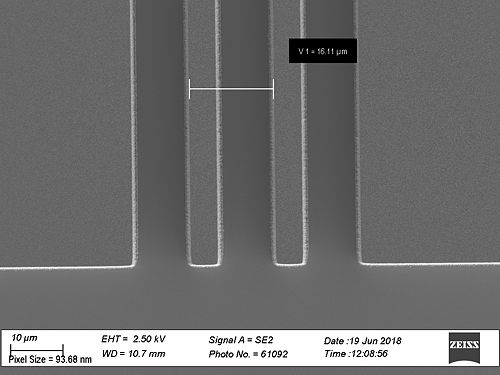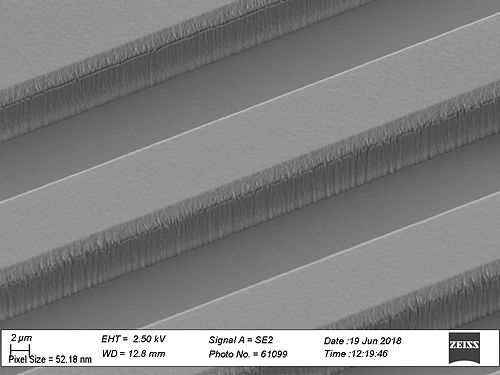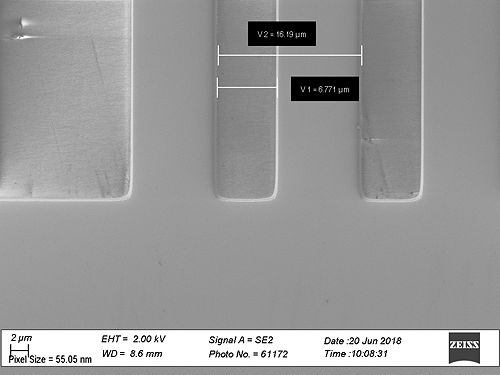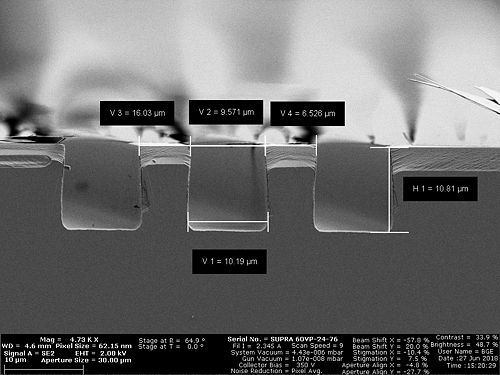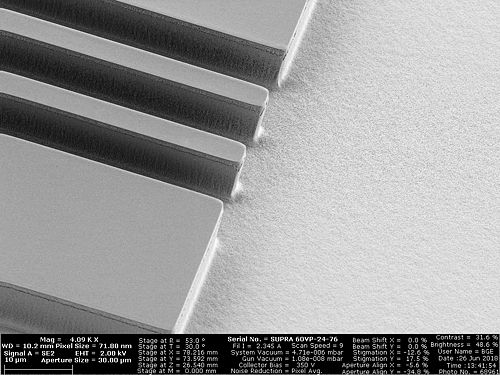Specific Process Knowledge/Etch/III-V ICP/InP-InGaAsP-InGaAs: Difference between revisions
Appearance
| Line 102: | Line 102: | ||
Image:S0_oxide_05.jpg|Sample S0: Top view of the oxide mask before etching. It is the TRAVKA50 mask, but it is clear that the CD reduction is about the 1-1.5 µm of the lines. | Image:S0_oxide_05.jpg|Sample S0: Top view of the oxide mask before etching. It is the TRAVKA50 mask, but it is clear that the CD reduction is about the 1-1.5 µm of the lines. | ||
Image:S4_06.jpg|Sample S4: Profile view. The recipe InP etch has been used. <br> The sample has been run on a SiO2 carrier wafer. <br> There is not much CD change compared to the oxide mask before the etch. <br> It seems like the SiO2 mask is gone and the sidewall angle from the mask has been transferred into the sample. <br> The sidewall profile is quit vertical in the lower part. | Image:S4_06.jpg|Sample S4: Profile view. The recipe InP etch has been used. <br> The sample has been run on a SiO2 carrier wafer. <br> There is not much CD change compared to the oxide mask before the etch. <br> It seems like the SiO2 mask is gone and the sidewall angle from the mask has been transferred into the sample. <br> The sidewall profile is quit vertical in the lower part. <br> Etch time 15 min | ||
Image:S5_05.jpg|Sample S5: Profile view. The recipe InP etch has been used but with modified Cl2 and N2 flows: N"=30 sccm Cl2=30 sccm. <br> The sample has been run on a SiO2 carrier wafer. <br> There is not much CD change compared to the oxide mask before the etch. <br> It seems like the SiO2 mask is gone. <br> the sidewall profile is overcutting probably due to too little passivation. | Image:S5_05.jpg|Sample S5: Profile view. The recipe InP etch has been used but with modified Cl2 and N2 flows: N"=30 sccm Cl2=30 sccm. <br> The sample has been run on a SiO2 carrier wafer. <br> There is not much CD change compared to the oxide mask before the etch. <br> It seems like the SiO2 mask is gone. <br> the sidewall profile is overcutting probably due to too little passivation. <br> Etch time 10 min | ||
Image:none | Image:none | ||
Image:S4_30dg_2_05.jpg|Sample S4: The sidewall roughness on the sample S4 is quit high | Image:S4_30dg_2_05.jpg|Sample S4: The sidewall roughness on the sample S4 is quit high | ||
Revision as of 07:51, 2 July 2018
Feedback to this page: click here
InP/InGaAsP/InGaAs etch
Unselective etch for large sized features and small aspect ratios by David Larsson, DTU Photonics, 2011
| Recipe | InP Etch 1/InP Precond 1 |
| Cl2 flow | 20 sccm |
| N2 flow | 40 sccm |
| Ar flow | 10 sccm |
| Platen power | 100 W |
| Coil power | 500 W |
| Pressure | 2 mTorr |
| Platen chiller temperature | 180 oC |
| Comment | Use SiO2 carrier (not Si) (Kabi/Bghe June 2018) |
| Results (InP Etch 1) | |
| Etch rate | 500-600 nm/min |
| Sidewall angle | 86-87 o |
| Selectivity (InP:SiO2, InP:HSQ) | 50:1 |
- Result of InP etching. David Larsson, DTU Photonics, 2011
InP etching June 2018
Done by Kabi and Bghe @danchip
Sample pattern before etching
- Oxide mask before etching.
-
Top view of the SiO2 mask before etching
-
Top view of the SiO2 mask before etching
Etching of an InP piece on Si carrier
InP piece patterned with SiO2. The piece was etched on top of a Si wafer without bonding. The recipe "InP etch" was used. The roughness looks high in the bottom of the etched areas, especially in the large open areas.
- Result of InP etching.
-
low roughness in narrow trenched
-
low roughness in narrow trenched
-
A little higher roughnedd is larger trences
-
Much larger roughness in open areas
-
Zoom in on the large roughness
-
closed look at the large roughness in the open areas.
Etching of an InP piece on SiO2 carrier
InP piece patterned with SiO2. The piece was etched on top of a Si wafer coated with SiO2 without bonding. The recipe "InP etch" was used. The roughness looks low in the bottom of the etched areas, even in the large open areas.
- Result of InP etching.
-
Top view: oxide is gone on the narrow lines, low roughness in the trenches.
-
Top view: low roughness in the trenches.
-
30 dg view: low roughness in the trenches
-
30 dg view: low roughness in the trenches
-
Top view: low roughness in trench and in the large area
Changing the Cl2/N2 ratio
- Result of changing the Cl2/N2 ratio.
-
Sample S0: Top view of the oxide mask before etching. It is the TRAVKA50 mask, but it is clear that the CD reduction is about the 1-1.5 µm of the lines.
-
Sample S4: Profile view. The recipe InP etch has been used.
The sample has been run on a SiO2 carrier wafer.
There is not much CD change compared to the oxide mask before the etch.
It seems like the SiO2 mask is gone and the sidewall angle from the mask has been transferred into the sample.
The sidewall profile is quit vertical in the lower part.
Etch time 15 min -
Sample S5: Profile view. The recipe InP etch has been used but with modified Cl2 and N2 flows: N"=30 sccm Cl2=30 sccm.
The sample has been run on a SiO2 carrier wafer.
There is not much CD change compared to the oxide mask before the etch.
It seems like the SiO2 mask is gone.
the sidewall profile is overcutting probably due to too little passivation.
Etch time 10 min -
Sample S4: The sidewall roughness on the sample S4 is quit high
-
Sample S5: The sidewall roughness on the sample S5 is quit low.

